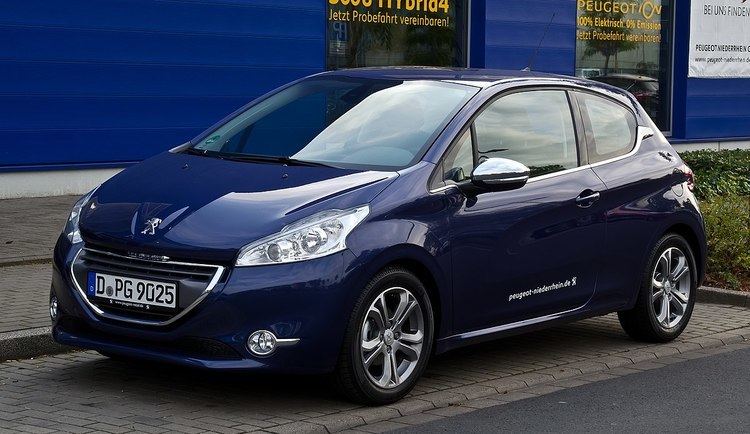Production March 2012–present Class Supermini (B) | ||
 | ||
Assembly France: Mulhouse (Mulhouse Plant)France: Poissy (Poissy Plant)Brazil: Porto Real (PSA Brazil)Indonesia: Jakarta (Gaya Motor)Malaysia: Gurun (NAM)Slovakia: Trnava (Trnava Plant) Body style 3-door hatchback5-door hatchback | ||
The Peugeot 208 is a supermini (B-segment in Europe) produced by the French automaker Peugeot and unveiled at the Geneva Motor Show in March 2012. The first 208 models were three-door hatchbacks produced in 2011 at the company's new plant in Slovakia. In June 2012, as five door hatchbacks became available, production of the 208 also commenced at Peugeot's French plants at Mulhouse and at Poissy.
Contents
Specification and design
The 208, developed under code name "A9", is built on the PSA PF1 platform and the weight is to be reduced by 173 kg (110 kg on average) compared with the 207 and still offer more space than the predecessor. The boot offers 285 L (10 cu ft) (VDA) of space, 15 L (1 cu ft) more than the 207, and the leg room in the rear seat increases 5 cm (2 in). The design was led by Pierre Authier, with Sylvain Henry as exterior designer.
The interior design is by Adam Bazydlo and the colour and trim is by Marie Sanou. The car will feature a tablet computer-like screen and panoramic glass roof surrounded by LED lights. The car is relatively aerodynamic with a drag coefficient, Cd, of 0.29.
Engines
All the petrol engines comply with the Euro 5 norm and the diesel engines have CO2-emissions of 99 g/km or lower. In addition to the four-cylinder petrol engines carried over from the previous model, from September 2012 the 208 has been offered with two new three-cylinder units with variable valve timing – the 1.0 VTi (68 hp) and 1.2 VTi (82 hp). The 1.0 comes with an advertised fuel consumption of 4.3 L/100 km (66 mpg‑imp; 55 mpg‑US) and a CO2 emissions value of 99 g/km.
The 208 GTI is fitted with a 1.6-litre turbo (1598 cc) four-cylinder in-line turbo petrol Prince engine producing 197 bhp @ 5,800 rpm and 203 lb ft @ 1,700 rpm, and is fitted with a six-speed manual transmission. This first GTI model has since been replaced by the 208 GTI by PeugeotSport which is directly derived from the limited edition '30ième Anniversaire Edition' which put out 208 bhp with revised suspension and an optional two-tone paint job along with a facelift of the original bumpers and other small changes. The GTI's Prince engine is shared with the Mini and various Citroëns.
The range of diesel units starts with the four-cylinder 1.4 e-HDi unit, originally introduced in 2010 for the 207, which provides 50 kW (68 PS; 67 hp) of power coupled, in the 208, with published fuel economy and emission figures of 3.4 L/100 km (83 mpg‑imp; 69 mpg‑US) and 87 g/km.
208 T16 Pikes Peak
In April 2013, a 208 T16 was tested by Sébastien Loeb at Mont Ventoux. Loosely based on the shape and design of the production 208, the T16 is a lightweight 875 kg (1,929 lb) vehicle that uses the rear wing from the Peugeot 908, and has a 3.2-litre, twin-turbo V6 engine, developing 875 bhp (652 kW; 887 PS) with the aim of competing at the Pikes Peak International Hill Climb. At Pikes Peak on 30 June 2013, Sébastien Loeb used the 208 T16 to break Rhys Millen's record time, set in 2012 on the first fully paved roads in the history of the competition. The previous record of 9:46.164 was shattered, and a new record time of 8:13.878 was set.
The car also won the hillclimbing race at the 2014 Goodwood Festival of Speed.
Rallycross
Team Peugeot-Hansen won the manufacturers title at the FIA World Rallycross Championship in 2015. Jérôme Grosset-Janin was runner-up in the FIA European Rallycross Championship in the same year.
Sales and production
Peugeot announced the 300,000th 208 was produced in February 2013.
